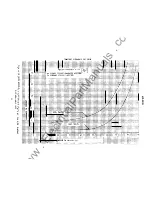
GEK-86105
auxiliary brush in each position on
the
case block.
This brush should be formed
high enough so that when the connection plug is inserted, it engages the auxiliary
brush before striking the main brush.
An improper adjustment of the auxiliary brush
could result in a CT secondary being mornent3rily open-circuited in a current
circuit.
�1ECHAN1CAL INSPECTION
The following mechanical adjustments should be checked:
Induction
Unit
The moving contact should just touch the stationary contact when the time dial is at
the zero position.
There should be sufficient clearance between the stationary
contact brush and its backing strip to allow for a least
l/32
inch wipe.
Set the
dial at the approximate setting that will be used when the relay is installed.
The disk and shaft assembly should have a vertical end play of
l/64
to
l/32
inch.
The set screws for the upper pivot and lower jewel screw must be tight.
The disk
should be centered (approximately) in the air gap of both the drive magnet assembly
and the drt.g magnet.
The disk and shaft assembly should turn freely without
noticeable friction.
The stop arm assembly, located near the top of the disk shaft� should be checked for
approximately
1/64
inch deflection of the leaf spring.
ELECTRICAL
TESTS
The following electrical checks should be made upon receipt of the relay. Note that
all tests are to be made with the relay in its case and in a level position.
All alternating-current-operated devices are affected by frequency.
sinusoidal waveforms can be analyzed as a fundamental frequency plus
the fundamental frequency, it follows that alternating-current devices
be affected by the applied waveform.
S
i nee non
harmonics of
(
relays
)
will
Therefore, in
order to properly test alternating-current relays a sine wave current
and/or voltage must be used.
The purity of the sine wave
(
i.e., its freedom from
harmonics)
cannot be expressed as a finite number for any particular relay; however,
any relay using tuned circuits,
RL
or
RC
networks, or saturating electromagnets
(such as
time overcurrent relays), would be essentially affected by non-sinusoidal
waveforms.
Similarly, relays requ1r1ng
DC
control power should be tested using
DC
and not full
wave rectified power.
Unless the rectified supply is well filtered, many relays
will not operate properly due to dips in the rectified power.
Zener diodes, for
example, can turn off during dips.
As
a general rule, the
DC
source should not
contain more than
5%
ripple.
Since drawout relays in service operate in their cases, they should be tested in
their cases or an equivalent steel case.
This way, any magnetic effects of the
enclosure will be accurately duplicated during testing.
A
relay may be tested
without removing it from the panel by using a
12XLA13A
test plug.
This plug makes
connection only with the relay and does not disturb the shorting bars in the case.
1 1
www
. ElectricalPartManuals
. com










































